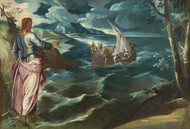Jacopo Tintoretto late September or early October 1518
Published by Therese Myles on 8th Nov 2019
Born in 1594 as Jacopo Robusti in Venice, Italy, Tintoretto is considered a master of 16th century Venetian painting. He apprenticed with Titian and studied the styles of many of Italy’s most prominent painters, including Michelangeo. Tintoretto favored oil paintings using rich colors and loose brushwork, as well as painting figures in motion and using opposing forces to create a deep pictorial space. To do this effectively, he would create small figures made from clay or wax to use as a model. He is linked to Mannerism, a style known for dramatic poses and exaggerated proportions and stances.
He frequently created religious paintings including “Saint Mark Rescuing the Slave” (1548), Susanna and the Elders (1555), and The Worship of the Golden Calf, a series of scenes for the church of Madonna dell’Orto, which took most of the 1550s to complete. As he aged, his style took on a more dark and mysterious air, such as in The Last Supper (1594), which shows the apostles and Christ assembled around a table that retreats into a shadowy, deep interior space. He passed away in 1594.

